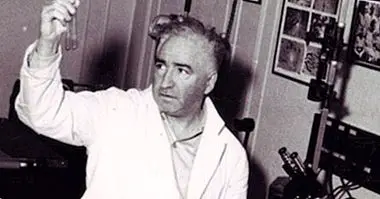5 differences between Intellectual Disability and Autism
Within the category of Neurodevelopmental Disorders suggested by the DSM-V (Diagnostic and Statistical Manual of Mental Disorders-Fifth Version), we find two subcategories that are especially popular and sometimes confusing: Intellectual Disability (ID) and Autism Spectrum Disorder (ASD) .
Insofar as they belong to the same category, ADD and ID share some characteristics. For example, its origin is early childhood and present limitations in specific or global areas of adaptive behavior. That is to say, in both cases the person who has the diagnosis has difficulties to develop in the personal, social, academic and occupational field of the form in which it is expected for its chronological age. However, both its diagnosis and its intervention have some important differences.
In this article we will review the Differences between Intellectual Disability and Autism (or, rather, the construct of Autistic Spectrum Disorders).
- You may be interested: "Autism Spectrum Disorders: 10 Symptoms and Diagnosis"
5 differences between TDA and Intellectual Disability
The Intellectual Disability and the TEA frequently coexist, that is, after making the corresponding evaluations both can be diagnosed at the same time (in this case we talk about a comorbidity between TDA and DI). In other words, it is very common for people with ASD to also present some manifestations of Intellectual Disability, and vice versa.
However, both are experiences that differ in some issues, what is necessary to know to access a timely intervention.
1. Intellectual skills vs Social communication
Intellectual Disability manifests itself in tasks such as reasoning, problem solving, planning, abstract thinking , decision making, academic learning or learning from one's own experience. All this is observed on a day-to-day basis, but it can also be evaluated using standardized scales.
In the case of Autism Spectrum Disorder, the great diagnostic criterion it is not the intellectual area, but the area of social communication and interaction ; what manifests in the following way: little socio-emotional reciprocity; little willingness to share interests, emotions or affections; the presence of a qualitative alteration of the communication (for example, lack of verbal or non-verbal communication, or stereotypes in the language); and a difficulty to adapt the behavior to the norms of different contexts.
- You may be interested: "What is the Intellectual Quotient (IQ)?"
2. Adaptive behavior
In the case of Intellectual Disability, the difficulty to reach the level of personal independence that is expected according to chronological age is notorious. That is, without the necessary supports, the person has some difficulties to participate in tasks of daily life, for example in school, work and community.
This does not happen because of a lack of interest, but because the person with ID may need a constant repetition of codes and social norms to be able to acquire them and act according to them.
For its part, the adaptive behavior of the ASD is manifested through the little interest in sharing the imaginative game or a little disposition towards the imitative game . It is also reflected in the lack of interest in making friends (due to the lack of intention to relate to their peers).
This little interest originates because many of the things that are in their next environments they can cause high levels of stress and anxiety , what they alleviate through patterns or interests and restrictive, repetitive or stereotyped activities.
- Related article: "Types of intellectual disability (and characteristics)"
3. Monitoring of standards
In relation to the above, the monitoring of social norms in the case of ASD can be hampered by the presence of restricted interests , which can range from simple motor stereotypies to the insistence on keeping things in a way that does not vary, that is, an inflexibility towards changing routines. Children with ASD often feel conflicted when their routines change.
On the other hand, in Intellectual Disability, the follow-up of instructions or norms can be hindered by the way in which logical processing, planning or learning works from own experience (for example, there may be a significant difficulty in recognizing behaviors). or risk situations without the necessary supports).
4. The sensory experience
Something that is also important in the diagnosis of ASD is the presence of sensory hyperreactivity or hyperreactivity . For example, there may be negative responses to some sounds or textures, or behaviors of excessive fascination to smell or touch objects, or to observe with attention and fixation objects with lights or repetitive movements.
In the case of Intellectual Disability, the sensory experience does not necessarily present itself in an exacerbated manner, since it is the intellectual experience that manifests itself most strongly.
5. The evaluation
To diagnose Intellectual Disability, Previously quantitative scales were used that measured the Intellectual Quotient . However, the application of these tests as a diagnostic criterion is ruled out by the DSM itself.
Currently, it is recommended to evaluate intellectual skills through tests that can offer a broad view on how they work, for example, memory and attention, visuospatial perception or logical reasoning; all this in relation to the adaptive functioning, so that the ultimate goal of the evaluation is to determine the need for support (which, according to the DSM, may be a mild, moderate, serious or profound need).
When the child is too small to evaluate through standardized scales, but their functioning is notoriously different from what is expected for their age, clinical evaluations are carried out. a diagnosis of Global Delay of Development can be determined (if it is before 5 years old).
In the case of ASD, the diagnosis occurs mainly through observation and clinical judgment of the professional. To standardize this, several diagnostic tests have been developed that require a specific professional training and that can begin to be applied since the child has reached the age of 2 years.
Currently they are very popular, for example, the Interview for the Autism Diagnosis-Revised (ADI-R, for its acronym in English) or the Scale of Observation for the Diagnosis of Autism (ADOS, also for its acronym in English).
Bibliographic references:
- Center for Documentation of Studies and Oppositions (2013). DSM-5: News and Diagnostic Criteria. Retrieved May 7, 2018. Available at //www.codajic.org/sites/www.codajic.org/files/DSM%205%20%20Novedades%20y%20Criterios%20Diagnósticos.pdf.
- Martínez, B. and Rico, D. (2014). Neurodevelopmental disorders in the DSM-5. AVAP seminars. Retrieved May 7, 2018. Available at //www.avap-cv.com/images/actividades/2014_jornadas/DSM-5_Final_2.pdf.
- WPS (2017). (ADOS) Autism Diagnostic Observation Schedule. Retrieved May 7, 2018. Available at //www.wpspublish.com/store/p/2647/ados-autism-diagnostic-observation-schedule.



















